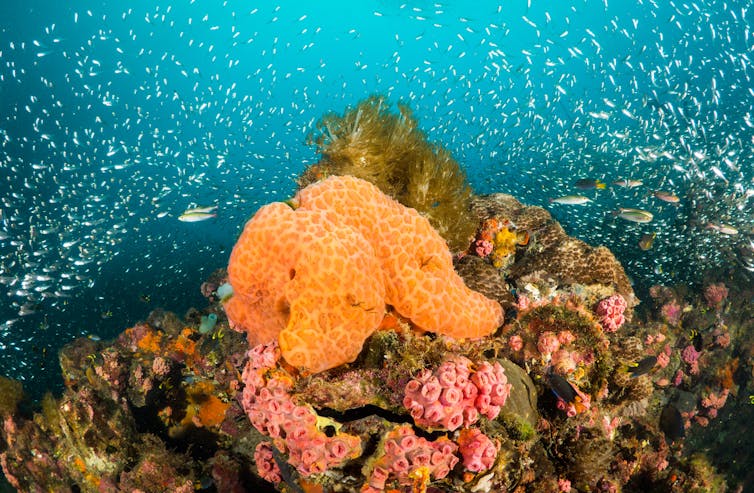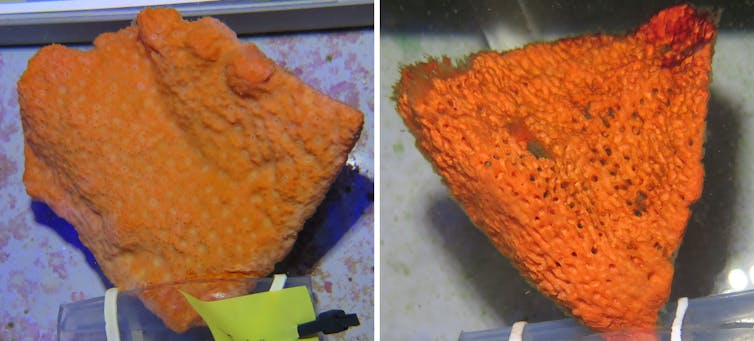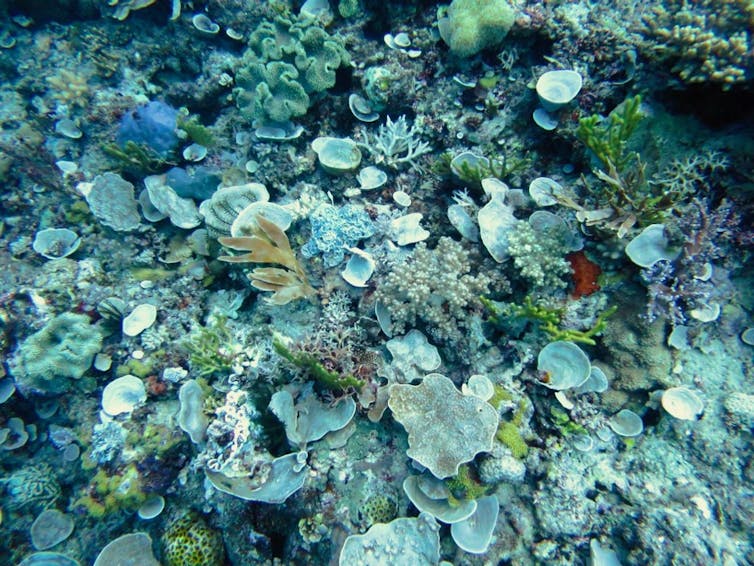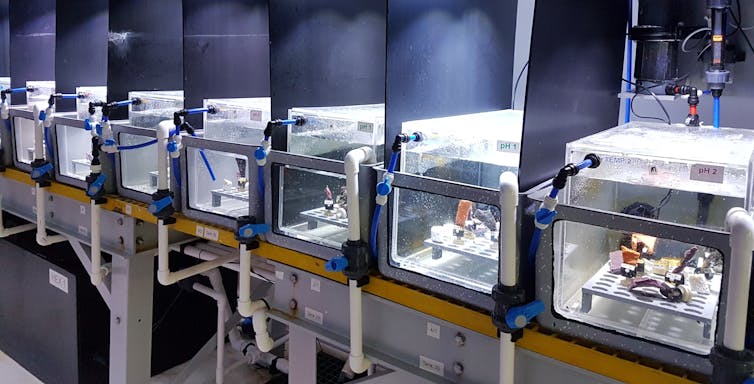
Marine sponges have started dying in vast numbers in coastal areas around the globe. Just this year, thousands of sponges turned white and died in New Zealand and in the Mediterranean Sea. This has been happening when the water gets too warm, but the underlying cause has remained a mystery. Until now.
We know these sponges play a crucial role in recycling key elements such as carbon, nitrogen, sulphur and phosphorus. In doing so, they keep nutrient cycles ticking over, to the benefit of all life on Earth.
This happens mainly through their very close association, or “symbiosis”, with diverse and abundant microbes. These microbes live in the sponge tissue as “life partners”. Sponges benefit from these tight relationships, as the microbes produce energy, recycle nutrients and provide beneficial molecules for the host.
In our new research, we found the cause of death is likely to be the sudden loss of a key microbe at high temperatures. This might rapidly poison the sponge, because this specific microbe is usually required to remove ammonia, a toxic metabolic waste product, from the sponge’s tissues. Without this crucial process, the sponge dies.
Experimenting with temperature
Marine sponges are animals of many shapes, colours and sizes found in every ocean, where they serve as food and provide shelter to many other organisms.
They spend their lives attached to the seafloor, where they feed by filtering thousands of litres of seawater every day, capturing, and later digesting, microscopic food.
Our study examined the tropical sponge Stylissa flabelliformis, exposed to either today’s average summer temperature (28.5℃) or the average temperature predicted for 2100 (31.5℃).
After eight weeks in the warmer water, the sponges were dying. There was no trace of the microbe that usually removes toxic ammonia in the sponge tissue. The microbial gene carrying the detoxifying function was completely absent from the sponge tissue, too. This confirmed no other microbe was fulfilling this role, and the detoxification of the tissue was simply not possible.
In contrast, the sponges kept at 28.5℃ were healthy. And the microbes in the sponge tissue were the ones we usually find when all is well.

Are we spoiling an evolutionary success story?
Sponges are some of the most ancient animals on the planet. They are found from the tropics to the poles in shallow and deep waters.
The sponge-microbe symbiosis has long been credited for this ecological success story. Depending on the sponge species, thousands of different microbial species reside in the sponge tissue.
In addition to supplying energy to the host, these microbes provide the sponge host with vital molecules the sponge itself cannot produce, such as essential vitamins, or compounds that deter predators. They also act as recyclers, transforming certain chemicals to reduce their toxicity or to make them digestible by the sponge. And they even produce molecules that can potentially benefit humans, such as anti-cancer drugs and antimicrobial agents.
The symbiosis between sponges and their microbial partners has allowed sponges to conquer large portions of the oceans’ seafloor. But human activities might put a serious dent in this epic success story. Last year, a marine heatwave induced tissue damage and bleaching in several sponge species in New Zealand. In the Mediterranean, all the sponges off the coast of Marseille died as a result of temperature extremes during Europe’s last summer.
While the underlying cause of these mass die-offs in warmer waters is not yet known, researchers have suggested the answer might lie in the breakdown of the symbiosis between the host and its microbes. Our research supports this hypothesis. These sponges may actually face a problem similar to bleached corals: increased temperature destroys the symbiosis, potentially causing a chemical imbalance within the sponge, with deadly consequences.

No strings attached? No way!
Most of the time, a strong symbiosis has an overwhelmingly positive effect on the host, but the risk of having such deep ties is dependency. With S. flabelliformis, it seems the sponge could not survive the loss of the only microbe that detoxifies ammonia and the “breakup” caused by increased temperatures.
Notably, this abundant species on the Great Barrier Reef and the West Indo-Pacific is not the only tropical sponge to experience changes in its microbes when it is unhealthy. This also happens in sponges living in temperate waters.

Sponges and their microbial partners are in trouble
Importantly, the 3℃ temperature rise to which we subjected our sponges does not represent a science-fiction scenario, but today’s extremes, already seen in nature. It is consistent with the marine heatwave that hit the Australian East coast between November 2015 and February 2016.
These extreme events are predicted to become more frequent and more severe as our climate continues to change. And such high temperatures could become averages by 2100 if we do not become carbon neutral globally as soon as possible.
This is worrying news for sponges, for the ecosystems they support and, by extension, for us. Sponges are extremely diverse with about 8,500 species currently described around the globe, host to microbes that could help humanity fight diseases and antibiotic resistance.
It is not intuitive to think highly of unassuming animals and their microbial partners when contemplating big issues such as climate change and the collapse of Earth’s biodiversity. But for the sake of our oceans, and ultimately, ourselves, we need to quickly make this collective effort and protect them accordingly.

Emmanuelle Botté, Research Officer, UNSW Sydney; Heidi M. Luter, Research Scientist, Australian Institute of Marine Science, and James Bell, Professor of Marine Biology, Te Herenga Waka — Victoria University of Wellington
This article is republished from The Conversation under a Creative Commons license. Read the original article.











